|
●Datable "Notre Dame" Conductus: New
Historical Observations on Style and
Technique5
Polyphony
The polyphonic conductus, on the other
hand, have rightly been appraised as some of the most impressive witnesses
to the innovative forms, styles, and procedures associated with the Notre
Dame school. Those in the datable repertory can offer weighty evidence for
charting the stylistic course of the conductus in the late twelfth and
early thirteenth centuries. In contrast to the monophonic corpus, clearer
indications of rhythm in polyphony make possible more significant
observations about chronological development.
ポリフォニックなconductusは、一方、革新的な様式、形式、そしてノートルダム楽派と関連した手順へのもっとも印象的な証人として正しい評価を受けている。datableなレパートリーにおけるそれらは、12世紀後半から13世紀初期にかけての時期のconductusの形式的コースを支持する重い証拠を差し出している。モノフォニックな体系とは対照的に、ポリフォニーにおけるよりはっきりとしたリズムの適用が、時系列的な発展についてのより重要な考察を可能にする。
In terms of large-scale musical forms, there is a further interesting point of contact between the monophonic and polyphonic repertories in the presence of the AAB cantio form in six of the datable multi-voice conductus (see table 10).
As this table shows, polyphonic examples with this musical form are typically
distinct from the monophonic. Their incorporation of sometimes lengthy
caudae and their preference for sequence structures or through-composed
strophic forms stands in stark contrast to the emphasis on regular strophic organization in the monophonic examples.57
There is a quite notable exception, though, to both these features in the
earliest member of the polyphonic cantio group, Ver pacis aperit. This two-voice, five-strophe conductus, the text of which was written by Walter of Chatillon to
celebrate the coronation of King Philip Augustus of France in
1179, is actually a trouvere contrafact.58 It features no melismas and, except for its added duplum, exhibits no appreciable differences from its monophonic counterparts. 59
Although this is only a single example, Ver pacis may well be indicative of a
style current in the earliest layer of the polyphonic conductus. Like
the'monophonic pieces that most closely resemble this type of trouvere
song form, it also suggests that other nonmelismatic cantio schemes in the
polyphonic Notre Dame conductus repertory may stem from the two or three
decades that preceded the turn of the
century.
大規模な音楽形式においては、モノフォニーとdatableな多声conductusにおけるAAB形式(cantio形式)の以下の6つのポリフォニーのレパートリーの間には、さらに興味深い対照的な点がある
(see table 10)。
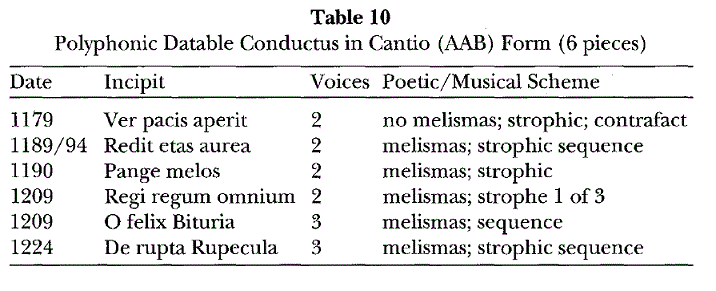
このtableが示すように、この音楽形式のポリフォニックな例は、典型的に、モノフォニーとは区別される。ある程度長いcaudaの挿入と、セクエンツィア構造あるいは通作詩句形式に対する好みは、モノフォニックな例における規則的なストリフィック構造の強調に対して、強いコントラストを作り上げる。57
しかしながら、もっとも初期のポリフォニックなcantioグループのメンバーには、(ある程度長いcaudaの挿入と、セクエンツィア構造あるいは通作詩句形式に対する選好に対する)両方の特徴に対しての、きわめて注目すべき例外が存在する。Ver
pacis
aperitである。
この2声の、5ストロフィーのconductusは、実際は、トロヴェールのcontrafactaである。メリスマは持たず、付け加えられたduplumを取り除くと、そのモノフォニックな相手(トロヴェールのcontrafacta)とほとんど変わりがなくなる。59
これは1例であるが、Ver
pacisは、ポリフォニックなconductusのもっとも初期の層に属する形式を示唆しているかもしれない。このタイプのトロヴェールの歌の形式に非常によく似ているモノフォニック作品のように、ポリフォニックなノートルダムのconductusにおける他のメリスマ的でないcantioスキーム(AAB)は、世紀の変わり目の20〜30年ほど前に根ざしていることをも示している。
It may also be significant that cantio forms occur
only once in datable polyphonic pieces from after the first decade of the
thirteenth century. This tendency leads to the supposition that with the
concentration on other features that prevail in later polyphonic conductus
(most notably the development of
increasingly complicated melismatic writing), through-composed musical settings became the norm, as did similar departures from uniform strophic structures in the production of conductus texts.
The only exception to these observations is the example of the three-voice
strophic sequence De rupta Rupecula from 1224, which differs from the other pieces in having a three-line
pes (A-B-C, A-B-C) , and is ikewise singular in restating the music of
all of its vocal parts nearly exactly upon repetition (see ex. 10).60
cantio形式が、datableなポリフォニー作品において、13世紀の最初の10年間に出現したことは、大変重要に思える。後のポリフォニックなconductus(次第に増大する複雑なメリスマ書法の発展はもっとも注目すべきである)に流行していく他の特徴への結集とともに、こうした傾向は、conductusの歌詞の生産における単一の詩句構造からの同様の出発のように、通作音楽形式が基準となったという仮定を導く。
こうした見方に対する唯一の例外は、3声のstrophic sequenceであるDe rupta Rupecula (1224年)である。(A-B-C, A-B-C) の3行pesを持っていることで他の作品とは異なっており、その声部のすべての音楽をほぼ正確に繰り返す(see
ex. 10)。60
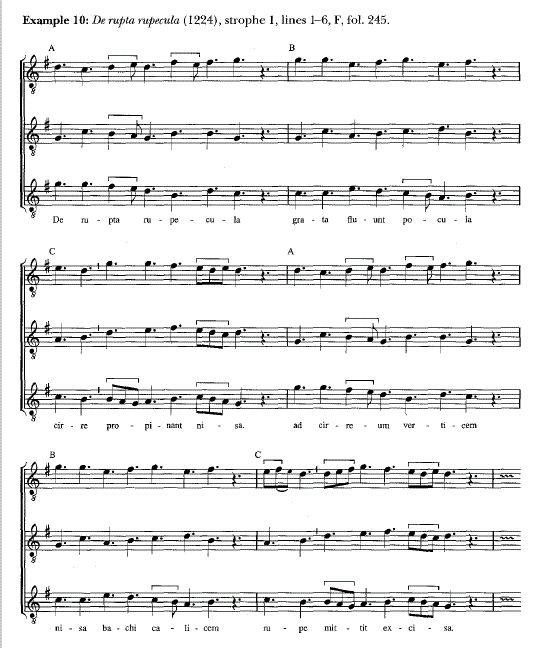
The datable polyphonic conductus, just like their monophonic counterparts,
also show changes in the musical intricacy of their text settings and the
incorporation of cauda sections over the years. This feature may aid in
pinpointing differences in style and serve as signposts for the chronological
evaluation of other Notre Dame conductus.
As with the datable monophonic repertory, the earliest layer of the polyphonic corpus is characterized by prevalent
syllabic declamation and an absence of caudae. This style is generally consistent with the works in the datable repertory
that indicate trouvere influence, except that in these instances the opening
repetition of the cantio form may be absent.
A nearly strict syllabic style is present in three of the four earliest
works, which also happen to display a regular strophic organization in
their texts: Novus miles sequitur(1173), Ver
pacis aperit (1179, in cantio form), and In occasu syderis
(1183). Thereafter, all of the examples contain melismas, matching their
appearance in the monophonic
pieces.
datableなポリフォニックなconductusは、それらのモノフォニックな相方同様、それらの歌詞設定における音楽的煩雑さと、長年にわたるcaudaの挿入を示している。こうした特徴は、形式の違いを特定するのに役立ち、そして、ノートルダムconductusの時系列的評価の道標として役に立つ。
datableなモノフォニックなレパートリーのように、ポリフォニック体系のもっとも初期層は、流行したシラブルのデクラマシオンとcaudaの不存在によって特徴づけられる。このような形式は、一般的に、トロヴェールの影響を受けたdatableなレパートリーな作品に一貫している。こうした例において、cantio形式のオープニングの繰り返しがないことを除いて。
より厳格なシラビック形式は、4つの最初期の作品(歌詞において規則的なストリフィック構造を示すような)のうちの3つに存在している。Novus
miles sequitur(1173), Ver pacis aperit (1179, in cantio
form), In occasu syderis (1183)の3つである。以後、すべての例はメリスマを含み、モノフォニックな作品ともマッチしている。
A more
embellished type of text setting, which signals the presence of a different aesthetic
approach, surfaces in Eclypsim patitur
from 1183, the earliest datable polyphonic conductus that also features
caudae. This work is especially distinguished from the earlier specimens
in the multi-part datable repertory through the style of its cum
littera sections (the
divisions of the piece that present the syllables in relatively quick
succession). Here the texted portions are much more ornate than the polyphonic examples
from previous years.
An especially noticeable trait in this piece is the way in which its two vocal parts frequently match
varying aggregates of ligated pitches that are often ambiguous with regard
to their harmonic simultaneity and rhythmic execution, if any such
specificity is indeed intended (see ex. 11).
テキストがより装飾的タイプ(異なる美的アプローチの存在を示す)のものは、caudaを特徴とするもっとも早いdatableなconductusである1183年のEclypsim
patiturで表面化している。この作品は、ことに初期の他の作品と、cum littera
形式による多声のdatableレパートリー面において区別される。歌詞部分は、以前のポリフォニックな例よりもはるかに装飾的となっている。
ことにこの作品における特別に注目すべき性質は、その2つの声部が、ハーモニーとリズムに関してはしばしばあいまいである連結されたピッチの変化する集まりに頻繁に一致する方法にある。もしもそうした特異性が意図的なものであるならば。(see ex. 11)。
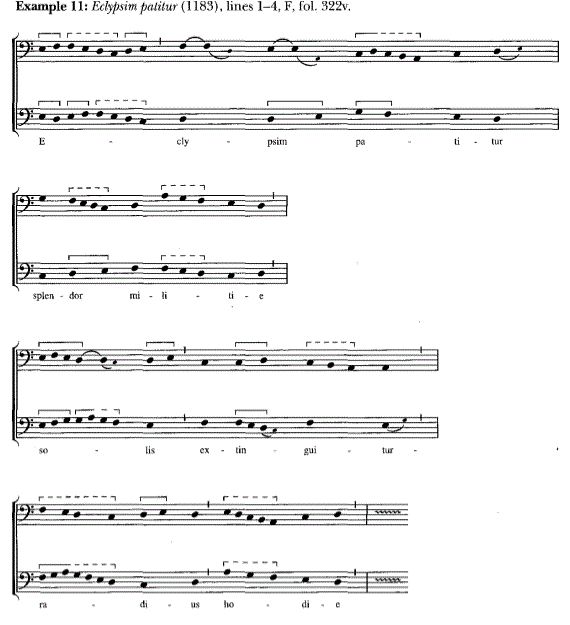
Stylistically, the conflicting pitch ratios of the ligatures and the notational
obscurities evident in example 11 are rather striking in their resemblance
to works associated with both the earlier Aquitanian polyphonic repertory
and the multi-part compositions that are now preserved in the so-called
Codex Calixtinus.
If Eclypsim patitur
is in fact representative of a polyphonic style that was current in the
1180s, it may serve to indicate a second point of contact beyond the indebtedness
of the Notre Dame composers to the forms and styles utilized in the vernacular
songs of the trouveres.
Through paleographical
and liturgical studies of the Codex Calixtinus, as well as the
identification of one of the composers cited therein with Albert, a cantor
of Notre Dame (d. 1177), other scholars have already demonstrated that the
Aquitanian, "Compostelan," and Notre Dame repertories may not be as
isolated as has been hitherto suspected.61 In support of this assertion,
the few records of twelfth-century polyphony from the area of Paris prior
to the Notre Dame sources show that practices that emerged in the South
also made inroads to the North (Huglo 1982).
Since Eclypsim
patitur may postdate the polyphony in the Codex Calixtinus by only a
few decades, it could well illustrate another type of polyphonic conductus
style prevalent at the time when Leoninus was supposedly active: a
concatenation of two ornately textured musical lines whose harmonic and
rhythmic ambiguity contrasts strongly with the balance and homogeneity of
musical materials under the hand of Perotinus and his contemporaries.
様式的には、相対する連結符のピッチ比と、example 11に明白に示されている記譜的あいまいさは、初期のアキテーヌポリフォニーや、多声作品(現在Codex
Calixtinusに保存されている)と関連した作品への類似性において印象的である。
もしもEclypsim patitur
が実際に、1180年代に流布したポリフォニックスタイルを代表しているのであれば、トロヴェールの世俗歌において利用されていた形式と様式に対するノートルダム楽派作曲家のindebtedness
を超えて、第2の接触点を示すのに役立つかもしれない。
Codex Calixtinusの古文書学や文学的研究を通して、ノートルダムのカントルだったAlbertとともに引用された作曲家の一人を可能な限り同定するように、他の学者たちはすでに、アキテーヌとComposteranとノートルダム楽派のレパートリーがそれぞれ孤立していないとこれまで考えられていたことを証明していた。こうした主張を支える中で、ノートルダム楽派に先立つパリ領域における12世紀のポリフォニーの数少ない記録は、南部で出現した実践が北部へ進んでいったことを示している。
Eclypsim
patiturは、数十年間、Codex Calixtinusのポリフォニーの日付を実際より遅らせることになったかもしれないが、(そのために)こうしたことは、レオナンが活躍していたと思われる時期に流行したポリフォニックなconductusの他のタイプのものをよく説明することだろう。つまり、ペロティヌスとその同時代の人々の手による音楽素材のバランスと均質性と、和声的でリズム的な曖昧さが強く対照的な、2つの装飾的な、質感の音楽ラインの連なりである。
Such
"Perotinian" consistency in a musical setting appears for the first time
either six or eleven years after Eclypsim patitur in Redit etas
aurea (1189/94), a conductus in praise of King Richard the Lion-Hearted.
This piece is representative of the classic Notre Dame conductus style and exhibits traits that were to persist throughout the early decades of the thirteenth century. In addition to the two lengthy, elegant caudae that end each strophic pair, there is a greater autonomy between the texted and melismatic sections in Redit etas than is
apparent in Eclypsim patitur. The cum littera sections in
Redit etas are now less ornate and recall the earliest syllabic pieces.
But even when a higher degree of embellishment does surface, as in the second strophe of this work, there appears to be a more conspicuous effort to balance the motion of each voice with the other, so that the earlier uncertainties of pitch alignment practically vanish (see ex. 12).
音楽の舞台におけるそのような「ペロタン風」の一貫性は、リチャード1世を称えるconductus,Redi etas aurea(1189/94)であり、それはEclyps impatiturの6年後または11年後に初めて現れる。
この作品は、古典的なノートルダムconductusを代表し、13世紀の最初の数十年間を貫く形質を示している。それぞれのストロフィックペアの最後の2つの長い、エレガントなcaudaに加え、Redit
etas の歌詞の部分とメリスマ部分との間には、Eclypsim
patiturの部分よりも偉大な自律性がある。Redit etasのcum littera部位は今やより少なく装飾され、最も初期のシラビック作品を思い起こさせる。
しかし、より高い程度の装飾性が表面化すれば、この作品の第2ストローフのように、そこにはそれぞれの声部が互いにバランスして動こうとするより華美な企図があきらかになることだろう。そのために、以前の音高の不確かさは実際にはわからなくなる(see
ex. 12)。
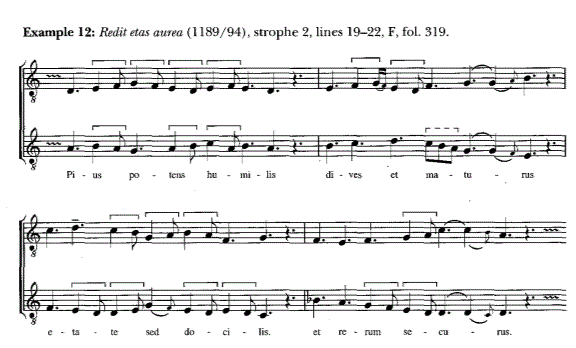
Except for the above observations on the form and
texture of texted portions, it is in the development of their caudae that
the ongoing changes in the polyphonic conductus are best apprehended.
Ernest Sanders devoted a sizable portion of his 1985 study to the
examination of caudae, and his findings are instructive. In addition to
noting the presence of melismas in all polyphonic conductus composed after
1189, he observed that the phrase structure of such sections becomes more
complex during the thirteenth century (l985b: 505, 508-09).
We
may add here that the formal design of such caudae, in terms of the interrelation and
correspondence of musical phrases to one another, also shows signs of increasing intricacy. Even in the
earliest instance of polyphonic cauda segments in Eclypsim patitur
from 1183 (see ex. 13), there are shared motives among parts, and
correspondences among phrases (in their use of melodic sequence and
rhythmic consistency), but the melodies themselves show little in the way
of stricter formal correlation. In fact, their synchronicity and
mirror-image counterpoint still recall features prevalent in the caudae of
the Aquitanian corpus.62
歌詞部分の形式とテクスチャーに関する上記の考察を除いて、そうしたcaudaの発展に伴って、ポリフォニックなconductusの進行する変化が最もよく理解される。Ernest Sandersは、caudaを研究し、有益な結果を得た。1189年以後に作られたあらゆるポリフォニックなconductusのメリスマの存在に注目することに加え、彼は、こうしたsectionのフレーズ構造が、13世紀の間により複雑になったことを見出した。
我々は、ここにさらに、音楽フレーズの相互関係および対応関係の点で、このようなcaudaの形式デザインがまた、増大する錯綜の兆候を示すことを付け加えることになるかもしれない。Eclypsim
patitur from 1183(see ex.
13)におけるポリフォニックなcauda部分のもっとも初期の例においてさえ、パート間の分配されたモチーフやフレーズ間の対応が見られる(メロディの流れやリズムの一貫性において)。しかし、メロディそれ自身はより厳格な形式上の関係は示さない。事実、こうした同調やミラーイメージ的対位は、アキテーヌポリフォニーのcaudaにおいて普及していた特徴をさらに呼び起こすのである。
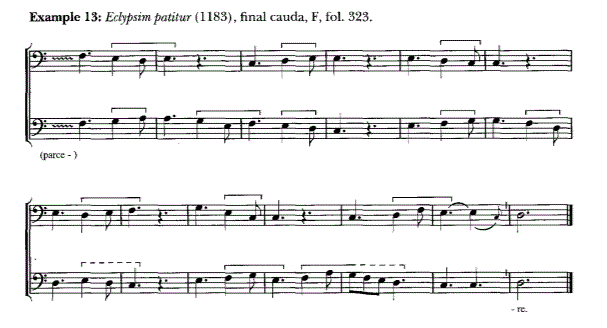
By 1189 or 1194, in the caudae of Redit etas
aurea, there is still no significant rhythmic interplay among the
phrases, but the music now betrays a seemingly new formal awareness in its
reliance on clearly articulated repetitive structures in each of the two
voices. In example 14, which
presents the first of the two caudae in Redit etas, the tenor states three phrases that are immediately repeated
with only a slight change in the last member to produce an open and closed
pair of cadences (ABC-ABC'). Meanwhile the duplum, which is consistently
disposed into four fourmeasure groups, presents a design with the form
DE-DF that closely mirrors the tenor's structure.
1189年または1194年までに、Redit etas
aureaのcaudaにおいては、フレーズ間の重要なリズムの相互作用はない。しかし、音楽は、2声部のそれぞれの明瞭にarticulateされた繰り返し構造に依存しながら、新しい正式な認識を裏付けているように思える。Redit etasの二つのcaudaの最初の方を示したexample
14においては、テノールは(ABC-ABC')のカデンツとなっている。その間にduplumは、4つのグループとなって、テノールと密接にミラーイメージを作りながら、DE-DF形式を保っている。
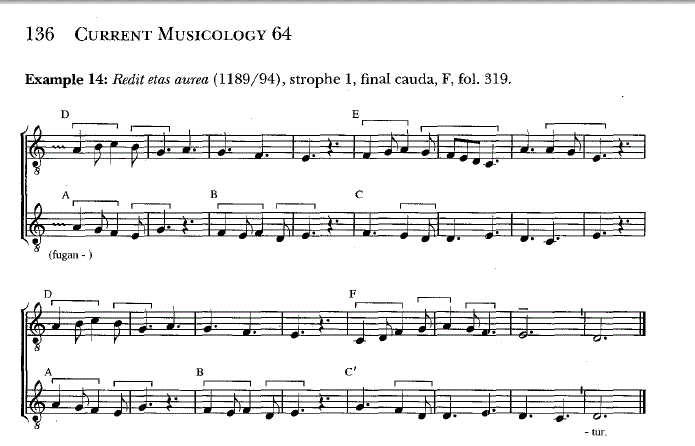
By the end of the first decade of the thirteenth
century, formal designs like the ones in the caudae of Redit etas
were further enriched by the dovetailing of phrases among the voices. This
device for achieving an unbroken
flow within a melismatic section by interlacing the entrances and cadences
of the different vocal parts served to forge
some of the most attractive and elegant caudae in the datable repertory.
One of the most splendid examples, which exhibits a sophisticated formal
structure as well as instances of rhythmic continuity, appears in a
melisma from the twopart Anni favor iubilei, probably from 1208 (see ex
15) .63
13世紀の最初の10年の終わりまでに、Redit
etasのこのような形式的なデザインは、声部間のフレーズのありつぎにより、さらに豊かになった。異なる声部の入りとリズムを交錯させることによって、メリスマ的な部位で途切れることのない流れを実現する工夫は、datableなレパートリーにおけるもっとも魅力的でエレガントなcaudaを作ることに役に立った。
This cauda divides into two parts, transcribed here as sections of eleven
and thirteen measures. The first of these two sections displays a tenor
with the form ABIB2BIB3 (B2 and B3 are consequent "answers" to
the preceding melodies of Bl). The duplum, however, shows a contrasting
structure (CDE1E2), and is further complicated by a short rhythmic overlap
with the phrases of the tenor beginning in the sixth measure of this section.
In the second portion of the melisma, the tenor continues to echo phrases
from the first (AB4B5). Here the B components generally progress in longs
while recalling the melodic contour from their counterparts in the first
section. As in Redit etas, the duplum is essentially independent
here, except for a brief exchange of motives between the two voices that
produces a fleeting snatch of canonic imitation beginning in the fifth
measure of this segment. The final six bars of this cauda continue to
exploit the relationships of the two vocal parts by featuring a repeat of
the duplum phrase E1 from section one, now transposed down a fifth in the
tenor
(E3).
このcaudaは、それぞれ11(小節)と13(小節)二つのsectionに分けられる。最初のsectionのテノールはAB1B2BIB3で示される。
duplumはしかしながら、CDEIE2という、対照的な構造を示している。さらにこのsectionの第6measureの最初のテノールの開始部分のフレーズにオーバーラップする短いリズムによって複雑化されている。
メリスマの第2sectionにおいては、テノールは最初からのフレーズ(AB4B5)を反響し続ける。B部分は、第1sectionのカウンターパートのメロディの輪郭を呼び起こしながら、進んでいく。Redit
etasのように、duplumは本質的には独立している。この部分の第5measureにおけるカノン的な模倣が一瞬の奪取を作る2声部間のモチーフの交換を除いて。このcaudaの最後の6measure(のテノールE3)は、section1のduplumのE1フレーズを完全5度下げて繰り返すことによって、2声の関係を開発し続ける。
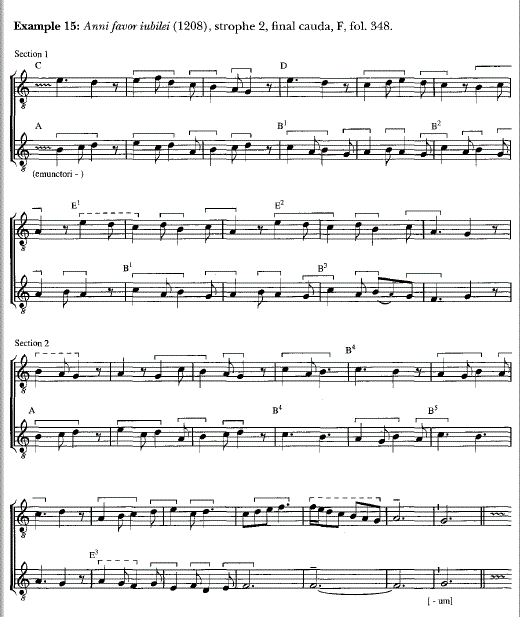
In the following decades, the caudae that appear in datable examples of polyphonic conductus continue to explore structural and melodic features analogous to those
detailed above, in some cases with an even greater emphasis on motivic
interrelationships among the voices, voice exchange, and occasionally canon.
In example 16a, for instance, the musical material in all the parts is so highly integrated that the opening three bars of this cauda contain nearly the entire melodic substance of its remainder. Furthermore, the distribution of rests is so carefully staggered that nowhere do all three parts cadence together, and two of the three voices are allowed to converge at only one point. Likewise, in example 16b, the complementary second-mode rhythms of the first seven measures are complicated even further by an exact imitation at the unison, four measures
in length and separated by the distance of only a single ternary long.
その後の数十年で、ポリフォニックなconductusのdatableな例にあらわれたcaudaは、2声間の関連、声部交換、時としてカノンなどを強調する場合がある構造的旋律的特徴(前述で明らかになった類似性を持つ)を探求し続けた。
example 16aにおいて、たとえば、すべての声部の音楽素材は非常に高度に集約されており、このcaudaの最初の3小節が残りの旋律的素材のほぼ全部を含んでいる。さらに、休符が注意深くあちこちに散りばめられており、すべての3声のカデンツは一緒にはなっておらず、3声のうちの2声は一つの点に集まるようになっている。
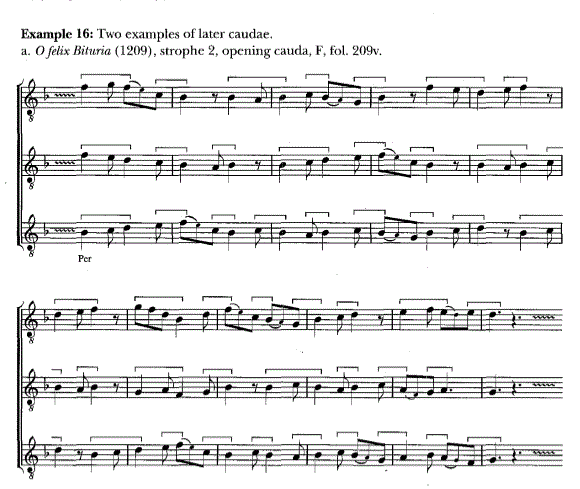
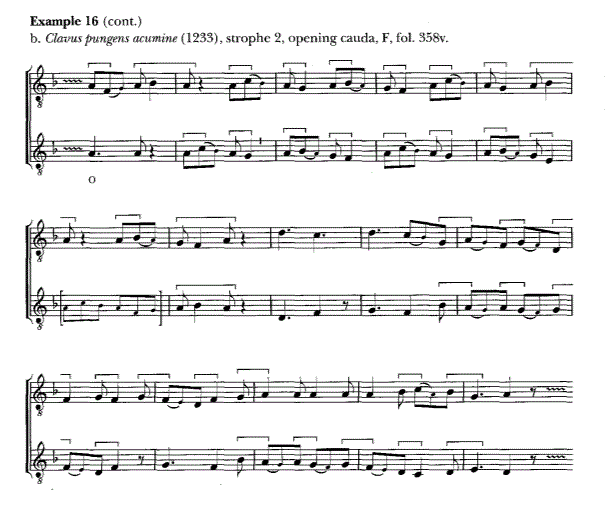
Ernest Sanders notes an additional trait in the later works from the thirteenth century, discernible for the first time around 1210, in the exploration of the new iambic rhythmic patterns that complete the system of six rhythmic modes (Sanders 1985b: 510-12; Roesner 1990: 41-62).
Although he correctly states that the earliest datable cauda with such rhythms appears in the final melisma of 0 felix Bituria from 1209, this final melisma presents some complexities in transmission since it also happens to appear independent of the conductus as a freely composed Benedicamus Domino setting from the Saint Victor codex (StV).
The presence of this cauda in the guise of an organum raises the question as to when this portion of the piece was composed and whether or not it originally served as part of the conductus, which otherwise is completely trochaic in its rhythms. 54
A possible impetus for appending this melisma to the conductus at a time
after its initial composition might be traced to the canonization of St.
William of Bourges and the institution at Notre Dame of a liturgical feast
in his honor. According to liturgical documents, William was sanctified
in 1218, nine years after his death, but his feast was not added to the
Parisian liturgy until more than a decade after he achieved sainthood.55
The later addition of a cauda in the new iambic rhythmic modes, based on
an earlier freely composed Benedicamus Domino, would have served to embellish the older conductus further, and would even tie it to the liturgy for possible performance on William's feast day.
But though the earliest appearance of the iambic rhythms of the second
and third modes is difficult to determine for certain, they were certainly
in use by the 1220s, as table 11 shows.55 Such evidence may not only help
to fix the dates of the incursion of the various rhythmic modes into the
conductus repertory, but also may illuminate the development of rhythmic
style in the discant clausulae and the early medieval motet.57
Ernest
Sandersは、13世紀になってから後、1210年頃に初めてはっきり見分けがつくようになった作品の付加的形質に着目し、6つのリズムモードシステムの仕上げとなる新しいiambic
rhythmic pattern(第2モード)を調べた。
彼はこのような新しいリズムを持つもっとも早期のdatableなcaudaが、0
felix Bituria from
1209の最後のメリスマ部分にあることを正しく主張したが、この最後のメリスマ部分は、transmission
におけるいくらかの複雑性を表している。なぜなら、St.V写本中のBenedicamus Domino
の設定として、conductusの独立があきらかだからである。
オルガヌムのようにふるまうこのcaudaの存在は、この作品のこの部分がいつ作曲され、conductusの一部分としてオリジナルに作られたのかどうかという疑問を湧き上がらせる。さもないと、conductusのそのリズムは完全にtrochaicになっていたはずだからである。
このメリスマが、その作曲後しばらくしてconductusに付け加えられた可能性のある誘因は、St.
William of
Bourgesの戴冠式や彼の名誉のための儀式的祭祀を執り行ったノートルダム寺院の設立に求めることができよう。儀式典書によれば、Williamは1218年に聖別されたが、それは彼の死後、9年が経過してのことであった。しかし彼の祭祀は、彼が聖職に叙せられたあと10年以上も執り行われなかった。
新しいiambicなリズムモード(第2モード)で作られたcaudaの後の付加は、以前の自由に作曲されたBenedicamus
Dominoを基盤にしていたが、古いconductusを装飾することとなり、そしてWilliamの祝日の可能な限りのパフォーマンスのための儀式と結びつけることとなった。
しかし、第2,3モードであるiambicリズムの最初期の出現は確認が困難であるが、table 11 が示すように、確かに1220年代までには使われている。こうした証拠は、conductusレパートリーに対するさまざまなリズムモードの出現期を決めるのに役立つだけでなく、ディスカントクラウズラや初期中世のモテットにおけるリズム形式の発展をも映し出すのである。(第2モードの発展について参照)
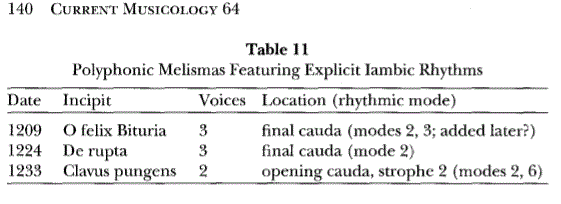
The above discussion of musical and textual traits in the datable conductus repertory has confirmed previous suggestions of notable changes in musical style during the decades surrounding the year 1200 and has built upon Sanders's earlier findings to propose some further elements that may be significant for weighing the chronological development of Parisian conductus style.
By investigating textual as well as musical features, and monophonic
as well as polyphonic works, the evidence of the entire datable repertory
confirms and expands Sanders's observations of progressive rhythmic, melodic,
and formal refinements in caudae; it also indicates that through-composed
schemes in both poetry and music had become more common by the early decades
of the thirteenth century.
Rather surprisingly, though, an opposite trend is seen in the texts of
several conductus that feature strophes disposed into paired versicles
(the socalled "sequence" forms). Here a tendency towards strophically
uniform texts mirrors the same sort of progression that can be seen in the larger history of the sequence repertory itself.
Furthermore, the analysis of individual poetic line schemes in the datable repertory suggests that stanzas composed solely of lines of six and ten syllables with a paroxytonic
accent did not survive long after the year 1200.
Finally and most notably, this investigation proposes that the presence in conductus of cantio forms modeled on the chansons of the vernacular repertories appears largely in the twelfth century and that the use of secular songs
as models or patterns for Notre Dame conductus declines or even disappears
after the end of the century.
前述のdatable conductusのレパートリーにおける音楽や歌詞の形質の討論は、1200年前後の数十年間における音楽形式の注目すべき変化に対する以前からの提案を確固たるものにしている。そして、Sandersの初期の発見は、パリ風のconductusスタイルの時系列的発展の重みを置く、重要ないくつかのさらなる要素を提供している。
音楽的特徴同様、テキストの研究によって、そしてポリフォニック作品同様、モノフォニック作品の研究によって、全体のdatableレパートリーのevidenceは、Sandersのcaudaにおけるリズム、メロディ、形式の洗練性の観察を確認し、発展させた。詩と音楽における通作スキームが13世紀初期数十年でより一般的になることが示された。
むしろ驚きをもって、逆の傾向が、ペアであるversicle(セクエンツィア形式と呼ばれる)を置くストローフを特徴とするいくつかのconductusのテキストにおいてみられる。ここでは、ストローフ的に単一なテキストに対する傾向は、セクエンツィアのレパートリーそれ自身のより大きな歴史において見られる進歩と同種のミラーイメージとなっている。
さらに、datableレパートリーの個々の詩行スキームの分析は、6シラブルと10シラブルの行だけで構成されるスタンザが、1200年以後はほどなく生存できなくなったことを示している。
最後に、そしてもっとも注目すべきことに、こうした研究は、母国語レパートリーのシャンソンをモデルとしたcantio形式のconductusにおける存在が、12世紀に大規模に現れ、ノートルダムconductuのためのモデルあるいはパターンとしての世俗歌の使用が、12世紀末以降には衰退あるいはなくなってしまったということを示している。
All the above features propose that pivotal stylistic transformations
to the conductus began in the decade preceding the year 1200, at the same
time that similar developments have been claimed for the repertory of organa
tripla and quadrupla. It is in this interval that many of the musical advancements
connected with the Parisian repertory, and specifically with the activity
of the composer Perotinus, were codified, and that the conductus began
to take on the musical trappings that are now most closely associated with
the Notre Dame school.
The conclusions of this study suggest, therefore, that in the two decades
surrounding the turn of the century, the Parisian conductus ceased to
be a type of song that relied on earlier models and became instead a sophisticated
compositional entity unto itself, on a par with the organa and motets that
accompany it in the major sources. Although they have been relatively ignored
for decades, the datable conductus provide an excellent means to paint
a more detailed picture of the history of Notre Dame music.
Thanks to their evidence, the development of nearly a century of medieval song in Paris may now be more closely documented, and historians may now begin to chart even more carefully the development of an important genre from one of the most significant chapters in Western European music.
こうしたあらゆる特徴は、conductusに対する重大なスタイルの改変が、1200年に先立つ10年に始まったことを示している。同時に、同様の発展が3声、4声のオルガヌムのレパートリーのために主張されている。パリ風のレパートリーに、ことにペロタンの格別な活躍に結びついた音楽的発展の多くが集大成されているということはこの時期に関してである。そして、ノートルダム楽派と密接に関連した音楽のわなを受け取り始めたのもこの時期である。
こうした研究の結果はそれゆえ、世紀の変わり目の20年間ほどにおいては、パリ風conductusが以前のモデルに頼った歌のタイプであることをやめ、かわりに、それ自身、主なるソースにおいて付随したオルガヌムやモテットと共に、洗練された構成主体となったことを示している。それらは何十年もの間比較的無視されてきたが、datable conductusは、ノートルダム音楽の歴史のより詳細な絵を描くための優れた手段を提供している。
こうした研究結果のおかげで、歴史家はより注意深く、ヨーロッパ音楽におけるもっとも重要な区切りのひとつから、重要な分野の発展を指し示すことができるのである。
Appendix
In Rama sonat gemitus 1164-1170 (a1; L1, 181) On the exile in France of Thomas Beckett, archbishop of Canterbury.
Novus miles sequitur 1173 (a3; Ell, 228) On the death of Thomas Beckett.
Dum medium silentium tenerent ca. 1174 (a1; K15, 99) Part of a longer prosimetrum beginning "In domino confido," delivered by the author to the University of Bologna; author: Walter of Ch~hillon.
Ver pacis aperit 1179 (a2; J32, 366) Coronation of King Philip Augustus of France; author: Walter of Chatillon.
Omnis in lacrimas 1181 (a1; K2, 253) Death of Henry I, count of Champagne.
Eclypsim patitur 1183 (a2; 17, 105) Death of Henry the Younger, son of King Henry II of England.
In occasu syderis 1183 (a2; Ill, 178) Death of Henry the Younger and praise to the future King
Richard the Lion-Hearted of England.
Anglia planctus itera 1186 or 1189 (a1; K12, 14) De,ath of Geoffrey, duke of Brittany (1186) and/or death
of his father, King Henry II of England (1189).
Venit Ihesus in propria 1187 (a1; K42, 365) Fall of Jerusalem to Saladin, impetus for the Third Crusade; author: Philip the Chancellor.
142 CURRENT MUSICOLOGY 64
Redit etas aurea 1189 or 1194 (a2; 18, 298) Coronation of King Richard the Lion-Hearted of England, or in celebration of his release (1194) from imprisonment by Emperor Henry VI, which occasioned a second coronation.
Pange melos laerimosum 1190 (a2; 115, 258) Death of Emperor Frederick Barbarossa.
Divina providentia 1190-1192 (aI; K9, 96) During the regency of Will am of Longchamp, bishop of Ely, under King Richard the Lion-Hearted.
Turmas arment Christieolas 1192 or 1193 (a1; K41, 352) Death of Albert of Louvain, archbishop of Liege, assassinated at Rheims.
Sede Syon in pulvere 1192-1197 (a1; K8, 321) Call to Henry II, count of Champagne, to deliver the Holy Land from Islamic forces.
Eclypsim passus toeiens 1197 (a1; K33, 104) Death of theologian Petrus Cantor. Die Christi veritas
1198 (a3; C3, 94) Conflict between King Philip Augustus and Pope Innocent
III over the rejection of Ingeborg of Denmark as queen of France.
Iherusalem Iherusalem 1198 (a1; K46, 169) Deaths of Henry II, count of Champagne (1197) and his
mother Marie, countess of Champagne (1198).
Pater sancte dietus Lotarius 1198 (a1; K61, 267) Installation of Pope Innocent III; author: Philip the
Chancellor.
Christus assistens pontiphex 1208 (a1; K48, 61) Installation of Peter of Nemours as bishop of Paris; author: Philip the Chancellor (the bishop's nephew).
Anni favor iubilei 1208 (a2;J25, 16) Call to the Albigensian crusade.
Regi regum omnium 1209 (a2;J22, 300) Death of St. William, archbishop of Bourges; canonized 1218,
feast added to Notre Dame calendar approximately a decade later.
O felix Bituria 1209 (a3; E8, 232) Death of St. William, archbishop of Bourges; dosing Benedicamus cauda in mode 2 possibly a later addition (ca. 1218? late 1220s?).
Rex et saeerdos prefuit 1209-1212 (a1; K49, 308) Dispute between Pope Innocent III and Emperor Otto IV over land conquests; author: Philip the Chancellor.
Alabaustrum frangitur 1223 (a1; KSO, 12) Death of King Philip Augustus of France; tentative author:
Philip the Chancellor.
O mors que mordes omnia 1223 (a1; K77, 241) Death of King Philip Augustus; tentative author: Philip
the Chancellor.
Beata nobis gaudia 1223 (a1; K44, 41) Accession of King Louis VIII of France (reg. 1223-1226).
De rupta Rupeeula 1224 (a3; F25, 82) Commemoration of the battle of La Rochelle.
THOMAS B. PAYNE 143
Clavus clava retunditur 1233 (a1; KS1, 64) Recovery of the Holy Nail of St. Denis; probable author:
Philip the Chancellor. Clavus pungens acumine 1233 (a1;J39, 65)
Recovery of the Holy Nail; probable author: Philip the Chancellor.
Aurelianis civitas 1236 (a1; K60, 25) Riot in Orleans between the townspeople and the clergy;
probable author: Philip the Chancellor.
Sol eclypsim patitur 1188 or 1252 (a1; K83, 331) Death of Ferdinand II of Spain, king of Leon (1188), or death of Ferdinand III, saint, king of Leon and Castile (1252).
Piece whose dating needs further discussion
(See Dronke 1989: 7)
Veritas equitas largitas 1226-1236 (a1; K62, 375) Reference to Louis IX under regency of Blanche of Castille?
Pieces whose dating has been rejected
(See Sanders 1985b: 521)
Nulli beneficium (a2; H7, 229)
Nema sane spreverit (a3; F12, 215)
Datable pieces from the "Saint Victor" Manuscript (StV) - not considered
GaudefelixFrancia 1226 or 1244 (a2; P3, 136) Coronation of King Louis IX of France, or in celebration of the anniversary of his coronation. Scysma mendacis Grecie 1244? (a2; P4, 320) Refers to the flight of Pope Innocent IV to France before Emperor Frederick II.
|









